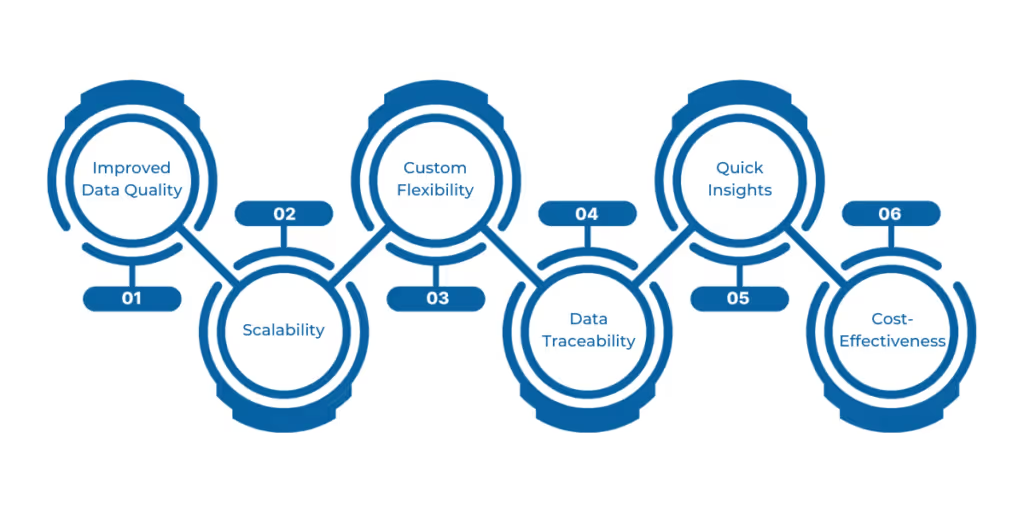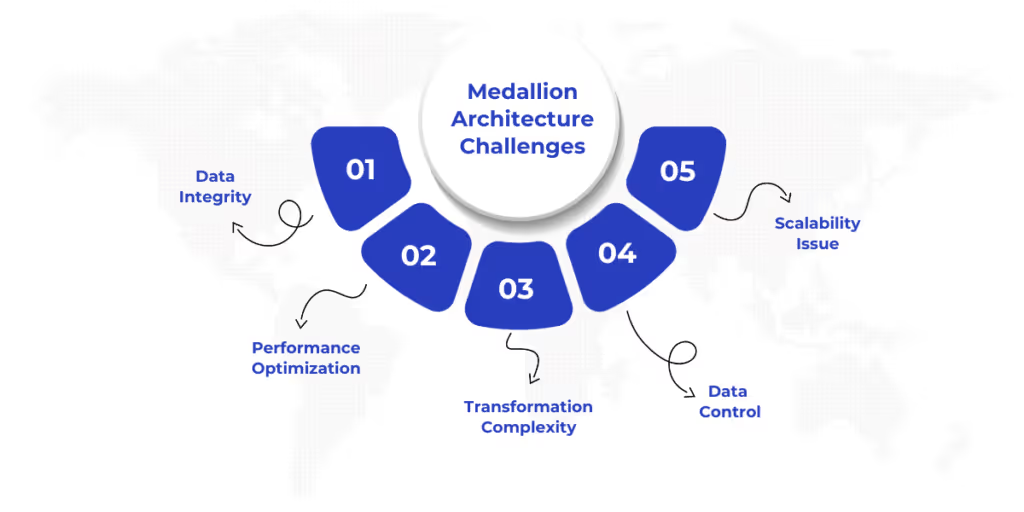

As your business grows, so does the volume of data flowing in from every direction, including customer activity, internal processes, and external systems. Without a structured way to manage it, this data becomes harder to track, harder to trust, and slower to use. Instead of helping you move faster, it holds you back.
With the growing need for scalable and efficient data systems, Microsoft Fabric provides a strong platform for building these structures. By combining powerful tools and a flexible environment, you can implement data pipelines that are both streamlined and effective.
One of the most practical ways to utilize these capabilities is by adopting the Medallion Architecture within Fabric Lakehouses. This blog explores how to design that architecture effectively, along with the benefits and challenges of managing data across its layered structure.
Medallion Architecture is a framework designed to manage data through its entire lifecycle, from raw ingestion to business-ready insights. It organizes data into three distinct layers: Bronze, Silver, and Gold, each handling data at a different stage of transformation.
Here’s a breakdown of these layers:
These three layers work together to ensure a smooth and efficient data pipeline, transforming raw data into valuable business intelligence.

Medallion Architecture offers several key advantages when it comes to designing and managing data pipelines. By structuring data into distinct layers, it ensures a more organized, efficient, and scalable approach to data processing.
Below are the main benefits of using Medallion Architecture in your data pipelines:
Suggested Read: Understanding Microsoft Fabric Lakehouse Architecture
Designing Medallion lakehouse Architecture in Microsoft Fabric involves a series of clear steps to ensure efficient data processing and management across different layers. Each layer plays a crucial role in transforming raw data into actionable insights, using the powerful tools available within Microsoft Fabric.
Here’s how you can design Medallion Architecture step by step:
By adhering to these steps, you can effectively implement Medallion Architecture in Microsoft Fabric Lakehouses, ensuring an efficient, scalable, and organized approach to handling your data from raw ingestion to business-ready insights.
Read Also: Understanding Microsoft Fabric Lakehouse Architecture

Designing and implementing Medallion Architecture in a data pipeline can come with its share of challenges. While the approach is highly effective for organizing and transforming data, several obstacles may arise during implementation.
Below are some common challenges along with practical solutions for overcoming them:
Ensuring data quality and consistency across the Bronze, Silver, and Gold layers can be difficult, especially when dealing with raw, unstructured, or inconsistent data sources.
Solution: Use automated data quality checks and validation rules during the transformation process in the Silver layer. Leverage Delta Lake's schema enforcement and data versioning capabilities to track changes and ensure that data remains consistent and reliable. Implement continuous monitoring and automated alerts for data quality issues.
As data volumes grow, maintaining optimal performance in terms of speed and processing time can become a challenge, especially when working with large datasets across multiple layers.
Solution: Leverage Spark Pools for distributed processing in Microsoft Fabric to handle large-scale transformations efficiently. Implement partitioning and indexing techniques in the Silver and Gold layers to optimize data retrieval and query performance.
Additionally, use Delta Lake’s time travel feature to manage versions and avoid costly reprocessing of unchanged data.
The transformations required between layers, especially in the Silver and Gold layers, can be complex and resource-intensive, particularly when dealing with large datasets or multiple data sources.
Solution: Break down complex transformations into smaller, manageable tasks and implement them incrementally to avoid overloading the system. Use Dataflows within Microsoft Fabric to automate and streamline the transformation process.
This ensures consistent, repeatable workflows that reduce manual intervention and errors.
Ensuring proper data governance, privacy, and security across the multiple layers is critical, especially with sensitive or regulated data.
Solution: Implement access controls and role-based security in Microsoft Fabric to restrict who can view or modify data in each layer. Use Azure Data Lake’s security features to enforce policies around data encryption, auditing, and data masking.
Establish strong data governance policies that define how data should be handled, tracked, and accessed throughout the pipeline.
Scaling Medallion Architecture to handle increasing data volumes, particularly when adding new data sources or expanding business operations, can be challenging without careful planning.
Solution: Use the scalability features of Microsoft Fabric, including Spark Pools and Delta Lake, which are designed to deal with large datasets and scale as needed. Partition the data in the Silver and Gold layers according to business needs (e.g., by date or region) to enhance performance and scalability.
Additionally, automate the data processing pipeline to efficiently manage and scale workloads.
Designing and implementing Medallion Architecture in Microsoft Fabric is a crucial step toward optimizing how your organization handles data. By organizing data into the Bronze, Silver, and Gold layers, you create a structured pipeline that streamlines data processing, ensures data consistency, and makes it easier to derive valuable insights.
At WaferWire, we specialize in helping businesses successfully design and implement Medallion Architecture in Microsoft Fabric. Our team provides expert guidance throughout the entire process, from structuring the layers to optimizing performance and managing data efficiently.
Regardless of whether you are adopting Medallion Architecture for the first time or refining your current system, we are here to guide you in creating a solution that stands the test of time.
Contact us today and let us guide you through designing Medallion Architecture in Microsoft Fabric with clarity and confidence.
Q. How can Medallion Architecture in Microsoft Fabric improve collaboration across teams?
A. By clearly organizing data into layers (Bronze, Silver, Gold), Medallion Architecture enhances data transparency and accessibility. Teams can work separately on each layer, facilitating better collaboration between data engineers, analysts, and business users.
Q. Can Medallion Architecture be used for real-time data processing in Microsoft Fabric?
A. Yes, Medallion Architecture can support real-time data processing. Using streaming data pipelines in Microsoft Fabric, data can be ingested and processed in near real-time, with the architecture ensuring the data is structured and ready for analysis in each layer.
Q. How do you manage versioning in Medallion Architecture when using Delta Lake?
A. Delta Lake offers built-in versioning that allows you to track and manage changes to the data. You can use the time travel feature to access previous versions of the data, ensuring data consistency and enabling rollback if necessary.
Q. What are the challenges of implementing Medallion Architecture in legacy systems?
A. Implementing Medallion Architecture in legacy systems may involve difficulties like data integration, system compatibility, and limited support for scalable data processing. Solutions include using ETL pipelines and Azure Data Factory for smooth integration and migration.
Q. How can Medallion Architecture help with regulatory compliance and auditing?
A. Medallion Architecture improves data traceability by providing a clear lineage of how data moves and transforms across layers. This transparency, combined with Delta Lake’s versioning and audit logging capabilities, ensures compliance with regulatory standards and simplifies auditing.

